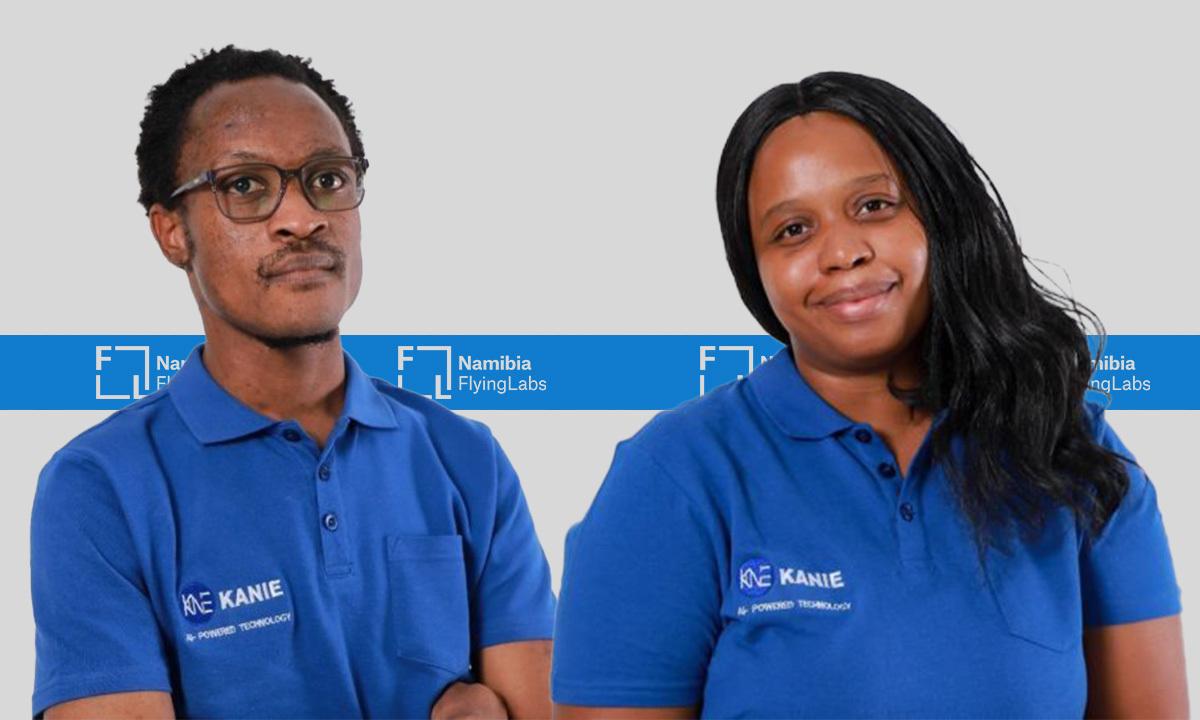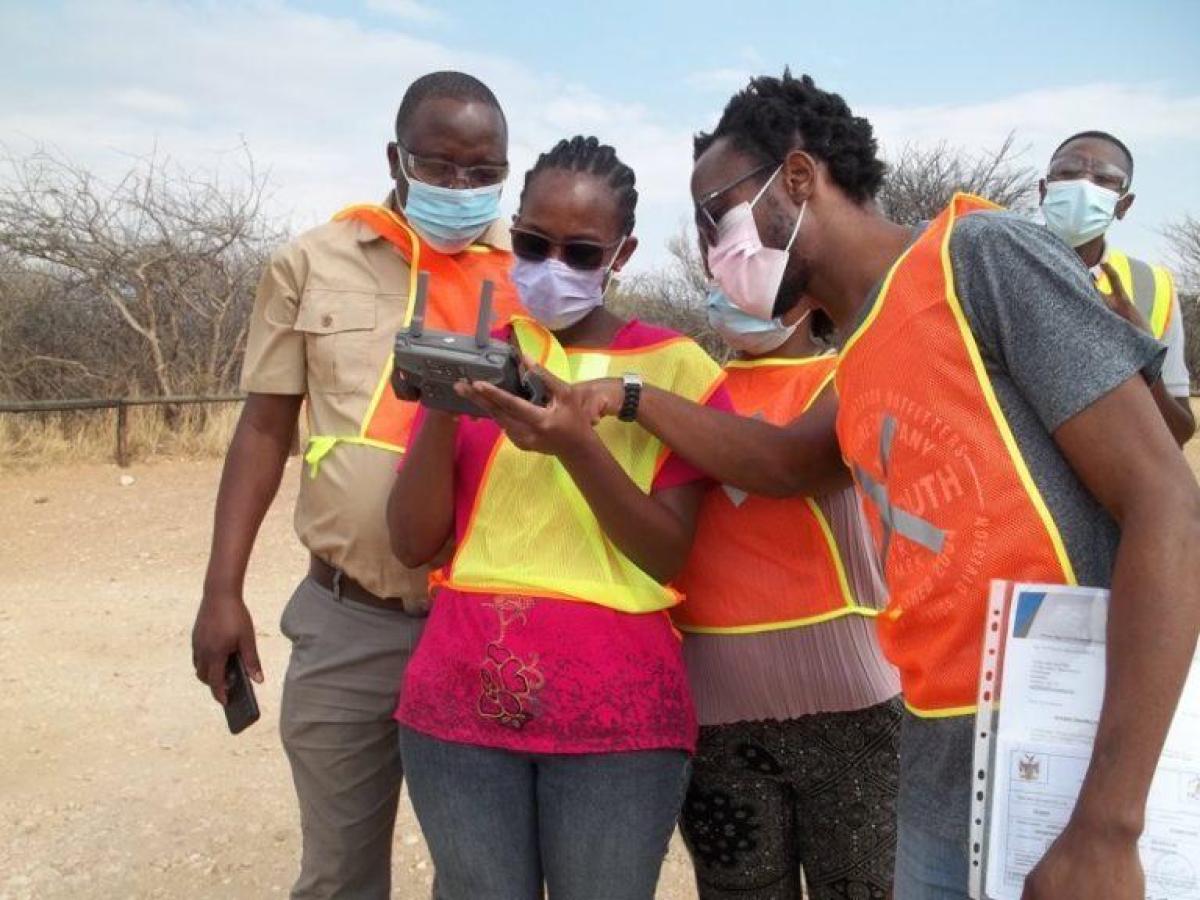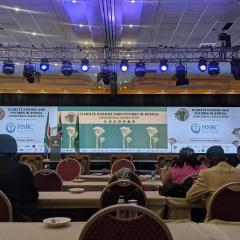
Building a Sustainable Ecosystem: Collaborative Growth in Namibia’s Drone Industry
February 20th, 2024

For today’s conversation about the value of collaboration in the Global South’s drone industry, we are joined by Namibia Flying Labs, whose team remains committed to harnessing the potential of drone technology and robotics to address societal challenges and uplift the lives of Namibians.
WeRobotics speaks with Namibia Flying Labs’ coordinators, Virginie Uwimana and Charles M. Kamba. Virginie holds a B.Eng degree in Civil Engineering from the Namibia University of Science and Technology (NUST) and is currently working towards her master’s degree in structural engineering at the same institution. She has worked for a Namibian multi-disciplinary engineering consulting firm where she gained experience in the design, supervision and management of projects in the field of structures, roads, water, and environmental engineering. She has also worked as a part-time lecturer at NUST. She is a strong advocate for breaking the stigma around drone technology and is passionate about exploring how robotics can be used to improve the lives of each African.
Charles has a professional background in Civil/Structural Engineering, and is experienced in project management, as well as procurement. He is proficient in GIS, as well as data management; and is a firm proponent of digital transformation, for local capacity development and streamlined humanitarian efforts.
In our discussion, we talk about the significance of collaborative efforts, emphasizing the vital role of building relationships with local communities and leveraging the interconnected nature of a drone ecosystem that transcends borders.

Let’s jump right into it! We’d like to hear about your experiences getting into drones. What drew you to this field?
Charles: My first experience with drones was in a professional setting. Virginie and I are both civil engineering professionals, and we worked a lot with surveyors. While working with them, we observed that they were using drones to collect data, which they then processed. That sparked an interest. We ended up procuring a drone at the company where we worked to do the data collection ourselves, and from there, we explored more use cases and learned what other people are doing. Now it's become a full-time thing but it started as an auxiliary tool for our engineering work.
And how different is the industry between then and now? Have you noticed any changes in how drones are used?
Charles: I would say the greatest change is that drones are more widespread and much more acceptable. When we started, it was so foreign. We would go to remote areas, and the drones would be quite intimidating for the local community. Without proper community engagement, it would be a very difficult exercise.But right now, after a lot of engagement with them, even small children know that it's a drone and there's excitement. That's the biggest change I have seen.
The other change I can mention is on the regulatory front. There's been a lot of evolution since the time we started utilizing drones.
Could you speak more about this evolution?
Charles: The positive part of it is that an attempt is being made. When we started, there were no regulations in our country. But now there is a law. A challenge is that the technology is moving way faster than regulations can catch up. Sometimes you reach a bottleneck because the law does not account for some forms of technology. However, overall, the reception is good, and the fact that the authorities are making an effort and actually come up with regulations is something good.
The focus of this blog series is what collaboration looks like within the drone industry with various stakeholders, and that includes other drone companies. How do you collaborate with other drone professionals? And do you see the benefit of collaborating to achieve even bigger impact?
Charles: Yes, we have definitely benefited from collaborations with people both who found us in the industry and those who we found. There's always a lot to learn. And the equipment is super expensive, so it’s easier if you can work together with other people – you bring in whatever you have, they bring in whatever they have. That way, you all grow together.
Generally we have been able to make good partnerships and work very well with other people. We are an NGO but we also work with people in the commercial sector. We do not necessarily compete with them in their work, but wherever they can support us, they do because of the relationships we established from the beginning. It’s actually been super beneficial to us in our work, and we really do get support from others and also support those we can.
Virginie: We try to create a network of equipment. So for example, if the university has a sensor on their drone, and I don't have it, I can lean on them. We're not all trying to buy the whole roster of equipment because that would be very expensive and the tech changes very quickly. So we lean on these partnerships and that's how we have managed to come as far as we have. If we can hold each other's hands, we can get more grants, more projects, and so on, as a collective rather than going it alone as an individual. And that goes for all of us: the people in education, other NGOs, and the commercial sector as well. For example, if we need a survey done, we have a list of surveyors that we can contract. We have that great relationship with people across the board in the ecosystem.
Would you say that the drone ecosystem in Namibia is thriving based on the work that you've done and the work that you've seen other companies doing? And what do you think would help the ecosystem thrive even more?
Charles: The demand and the interest are there. I think the industry will grow further, and with people doing it safely and legally. With effective, enforceable regulations, the ecosystem can accommodate more users, new operators.
As we wind up, let’s talk a little about cross-border collaboration, which is the spirit of the Flying Labs Network. Though the Flying Labs operate in different regions, they still work together and engage in important knowledge sharing. What role do you think international collaboration plays in furthering the adoption and impact of drone technology in the Global South?
Charles: We recently had a learning project pertaining to regulations where we were engaging with other Flying Labs, getting to learn how things are being done, how the regulatory system is in different countries, licensing, et cetera. And from that, yes, there was a lot of value added.
However, that’s actually not where it ends. International collaborations become more meaningful when the CAA in your country is engaged and interested in innovation. You can then do the surveys, collect the data, and then the CAA can build upon that and develop informed regulations. So international collaboration does add value, but it has to happen alongside collaboration with the people with the influence to make changes that matter, changes that count, and who have the same vision as you.
Virginie: I agree. The only thing I will add is that even when we don't directly collaborate with each other to do projects, the fact that we have this database of use case templates and the like goes a long way, especially when you're exploring something new, something you haven't done in your own country. We can see that it has been done in Nigeria and Kenya and Uganda and it's been successful, so why not do it here in Namibia? That relationship, that database, is a beautiful indirect collaboration.
This has been a really fruitful conversation. Thank you so much for sharing your time, experiences, and insights.
In the experience of Namibia Flying Labs, engaging with a diverse array of stakeholders, from local communities to international organizations and civil aviation authorities emerges as the linchpin of success. A big thank you to Namibia Flying Labs not only for their generosity but also for the valuable demonstration of the power of partnership as a catalyst for positive change.
Next, we’ll explore what it means to be a drone professional and the opportunities that exist in this industry in the Global South.
Recent Articles

